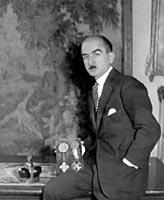Lightyears Collection
Prince Matchabelli
Had it not been for the Bolshevik takeover of Georgia in 1921, Prince Matchabelli would be an "unknown" today. Prior to 1921, Guéorgui Vassilievitch Matchabelli (1885-1935) served briefly as Georgia's ambassador to Italy, was known to love opera (and at least one lady of the opera), and, in 1916, had married Norina Gilli, an Italian actress. Some biographies, possibly to support his credentials as a perfumer, state that he had studied chemistry in Germany. In 1924, the Matchabellis found themselves in the United States, penniless refugees from the Bolshevik terror. The prince, it is said, could only go out at night in a dinner jacket for all his other clothes were being held as security for debts he could not pay. His situation was similar to other formerly wealthy nobles fleeing the Bolsheviks. We don't know how the Matchabellis got the idea to start a perfume business or where they got their first formula. It is worth noting that in 1924, Coco Chanel entered into a marketing agreement for her No.5 perfume. Chanel had been introduced to perfumer Ernest Beaux, himself an exile from Russia, by another refugee from Russia, Grand Duke Dmitri Pavolvitch — whose sister, Marie, who had worked for Chanel, would later consider launching a perfume of her own in the United States. Perhaps as Russia had been the home of so much perfume, perfume was in the air for the Matchabellis, and in 1926 a perfume could still be launched with very modest capital.
In 1926 the Matchabellis went a bit deeper into hock to set up their perfume company. Princess Norina Matchabelli is said to have designed the trademark bottle — a bottle said to be a small replica of Prince Matchabelli's (lost) crown. A publicist arranged for an interview with Collier's magazine. Somewhere a formula was obtained. Stories were told that it came from Matchabelli's grandmother and that Matchabelli was an amateur chemist. The interview was a success. The fragrance generated sales. More fragrances were introduced. In 1931, Princess Matchabelli became a dedicated follower of Meher Baba; in 1933 the Matchabellis divorced. Prince Matchabelli died in 1935 and was buried in Mt. Olivet Cemetery in Queens, New York. The Prince Matchabelli perfume business was sold to Saul Ganz in 1936 for $250,000. Ganz appointed his son, Paul H. Ganz, to be president of the company. In 1941 Prince Matchabelli was sold to Vicks Chemical Company. In 1958, Vicks sold Prince Matchabelli to Chesebrough-Ponds. Chesebrough-Ponds was acquired by Unilever in 1987. In 1993, the Chesebrough-Ponds division of Unilever sold the Prince Matchabelli brands to Parfums de Coeur, Ltd. In the fall of 1954, General Motors gave away 1,016,920 bottles of Prince Matchabelli perfume to promote the introduction of the 1955 Chevrolet. The advertising campaign for Prince Matchabelli's Wind Song perfume is believed to be the first campaign the industry has ever used for a woman's fragrance that featured images only of men. Perfumes By Prince Matchabelli
—— ## ——
If you have any comments about Prince Matchabelli, please share them with us using the message sender below. |
|


Philip Goutell
Lightyears, Inc.



